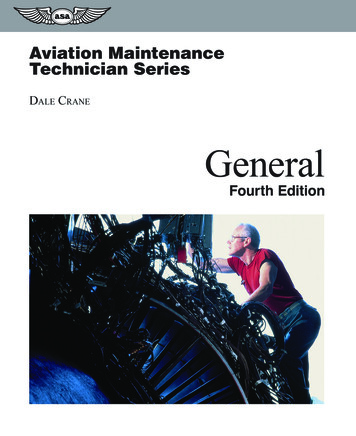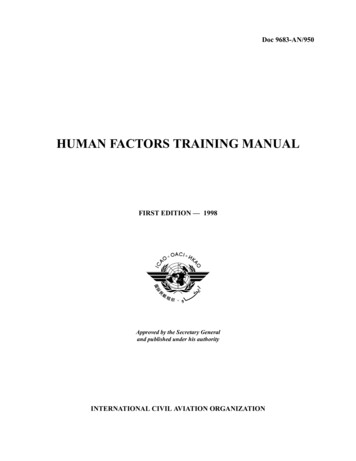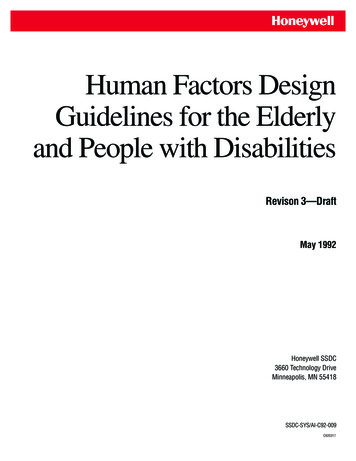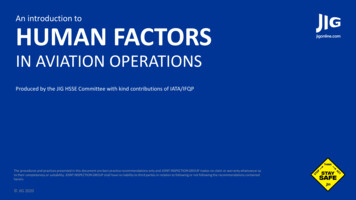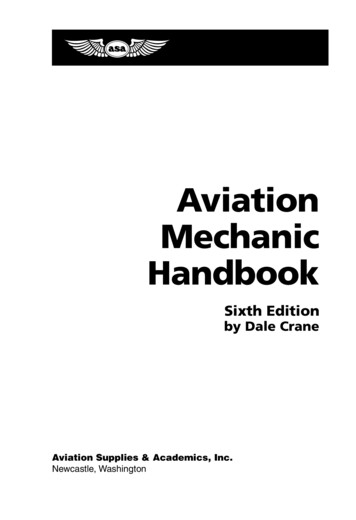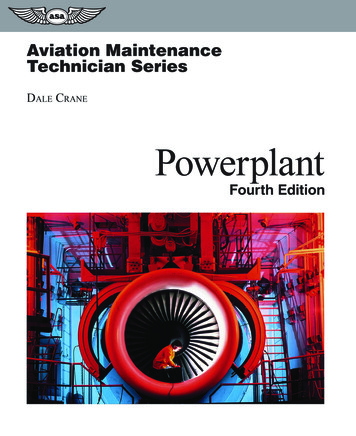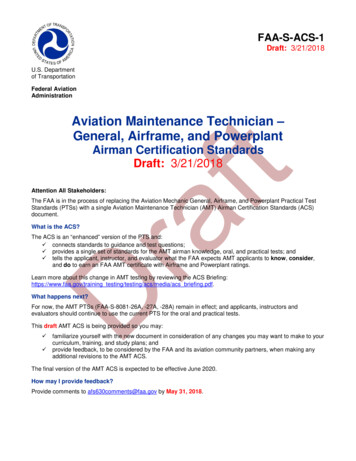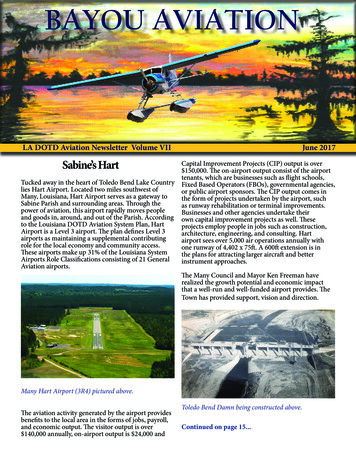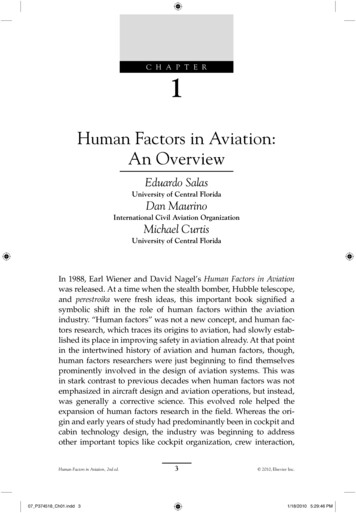
Transcription
C H A P T E R1Human Factors in Aviation:An OverviewEduardo SalasUniversity of Central FloridaDan MaurinoInternational Civil Aviation OrganizationMichael CurtisUniversity of Central FloridaIn 1988, Earl Wiener and David Nagel’s Human Factors in Aviationwas released. At a time when the stealth bomber, Hubble telescope,and perestroika were fresh ideas, this important book signified asymbolic shift in the role of human factors within the aviationindustry. “Human factors” was not a new concept, and human factors research, which traces its origins to aviation, had slowly established its place in improving safety in aviation already. At that pointin the intertwined history of aviation and human factors, though,human factors researchers were just beginning to find themselvesprominently involved in the design of aviation systems. This wasin stark contrast to previous decades when human factors was notemphasized in aircraft design and aviation operations, but instead,was generally a corrective science. This evolved role helped theexpansion of human factors research in the field. Whereas the origin and early years of study had predominantly been in cockpit andcabin technology design, the industry was beginning to addressother important topics like cockpit organization, crew interaction,Human Factors in Aviation, 2nd ed.07 P374518 Ch01.indd 33 2010,2010 Elsevier Inc.1/18/2010 5:29:46 PM
41. HUMAN FACTORS IN AVIATION: AN OVERVIEWcrew fitness, judgment, and automation. In all, their book should beconsidered a seminal contribution to aviation research as a whole.It represents one of the first books to present human factors topicsrelevant to aviation in a manner accessible not just for human factors professionals but also to pilots, aviation industry personnel,and others casually interested in the topic area.In March of the same year, Avianca Flight 410 crashed into mountains shortly after taking off from a Colombian airport, killing allpassengers and crew aboard (Aviation Safety Network, n.d.). Theofficial cause of the accident was determined as controlled flightinto terrain. This was precipitated by poor crew teamwork andcockpit distractions, including nonflying personnel present in thecockpit. Mentioning the tragedy of this accident following praise onthe impact of the initial edition of this book serves to illustrate animportant point in aviation research: Despite what is accomplishedin terms of safety and operational improvements in aviation, thework is never done. Like any other form of transportation, the prospect of having a 100% safety record in aviation is improbable. Ashumans, our propensity to propel technology design into futuristic states will always drive the need for the research community toaddress evolving demands of aviation.At any point in the history of human factors in aviation, one couldcharacterize its current state at that time by the progress that hadbeen made and by the opportunities that presented themselves forthe future. Keeping this in mind, in this chapter we aim to providea brief snapshot of aviation human factors since the first edition ofthis book. We will first highlight a few brief themes that show theprogress that has been made in aviation research since the first edition. Following this, we will talk about the opportunities that we ashuman factors professionals, pilots, instructors, maintenance personnel, air traffic controllers, and interested parties in general arepresented with currently to drive future generations of aviation. Toconclude, we will provide a short overview of the chapters that follow in this edition. In all, we hope this chapter orients the reader tothe causes and effects that guide the cutting edge of our field now,and whets the appetite of inquisitive minds to explore the subsequent chapters of this edition further.07 P374518 Ch01.indd 41/18/2010 5:29:46 PM
PROGRESS SINCE THE FIRST EDITION5PROGRESS SINCE THE FIRST EDITIONA little more than two decades has passed since the first edition ofthis book. Since that time, the industry has continued to change,technology has improved, and demands on crews have shifted.In part, the progress that scientists and developers have made inthe topic areas covered in the initial edition have perpetuated thematuration and evolution of aviation. There have been a numberof advances to classic human factors topic areas such as cockpitdesign in addition to the further development of several topicsthat were just burgeoning at the time of the first edition. The progress that has been made is too far-reaching to sufficiently cover inthis chapter—in fact, we really don’t do that here; other forumswill have to document that. Despite this, we feel that there are several general areas in which progress has helped shape the evolving industry. We next briefly touch on two topic areas and howthese have influenced training, technology, and flight procedure ingeneral.Training Crews Instead of Individuals—the Importance ofTeamworkIn the mid-1980s the focus of attention for most pilot training programs still relied heavily on development of technical skill. Littleemphasis was placed on developing teamwork skills within theflight crew. Evidence in the form of accident and incident reportdata suggested that suboptimal crew interactions were contributing to a noticeable number of human errors in the skies. Aroundthis time, a number of important publications began surfacingwith a call for increased emphasis on developing crew team behaviors in addition to the already ingrained technical skills requiredin flight (Foushee, 1984; Foushee & Helmreich, 1988; Orlady &Foushee, 1987).Since the genesis and initial investigations into how crew interaction influences the flight process, the concept of crew resourcemanagement (CRM) has been developed into an important aspectof aviation. The complexity of the interacting variables within theconcept of CRM have spawned research and subsequent progress07 P374518 Ch01.indd 51/18/2010 5:29:46 PM
61. HUMAN FACTORS IN AVIATION: AN OVERVIEWinto many aspects of the inputs, processes, and outputs of CRM asa whole. This includes investigation of inputs such as how teamcomposition, cohesiveness, and organizational structure influencecrew behavior (Guzzo & Dickson, 1996). In addition, researchershave aimed to improve our understanding of team processes suchas communication and leadership, among others (Salas, Burke,Bowers, & Wilson, 2001). This has led to the widespread incorporation of CRM training in the curriculum. This includes focusingon crew behavior in full flight training simulations such as LineOriented Flight Training (LOFT) and development of evaluationmethods to accurately assess the pilot skill not only for technicalskill but also in the less concretely observed behaviors that makeup CRM. What has resulted is progress from a well-thought-out,yet unproven, concept for improving cockpit performance to atested, successful method that is widely used and accepted in theaviation community for flight crew training. The development ofCRM has resulted in a shift from the individualistic focus of training technical skill to the complexity of teamwork that affects standard flight operations.Technological Advances—Shifting Performance RequirementsAs one would expect, technological advance has served both asa product of progress made in aviation human factors and as acatalyst for new directions of research in the field. Technologicaladvance has influence in all aspects of aviation from operations totraining. Although it is difficult to get a snapshot of all advancesin this area due to continual and rapid growth, there are somegeneral topics that represent many of the more specific areas ofresearch that are constantly at the cutting edge.In the 1980s the technological and operational realization of automated systems in aviation was just starting to take shape. Therewas little question as to whether or not automation would havean increased role in aviation, but the impact of that automation oncrew performance was largely unsupported by research (Wiener,1989; Wiener & Curry 1980). Automated systems became moresophisticated, and research into operational concerns such asmode awareness (Sarter & Woods, 1995) and automation surprise07 P374518 Ch01.indd 61/18/2010 5:29:46 PM
PROGRESS SINCE THE FIRST EDITION7(Sarter, Woods, & Billings, 1997), as well as theoretical works onutilizing automation (Parasuraman & Riley, 1997; Parasuraman,Sheridan, & Wickens, 2000) tempered the “rush to implement”automation mentality. Instead, these works encouraged thoughtful inclusion of automation and consideration of issues associatedwith automation in parallel to the obvious benefits. The modernaircraft now features many exclusively automated features notpossible in previous generations of aircraft. Although there are stillchallenges with optimizing human-automation interaction, progress in the last two decades has afforded automated features thatare designed with human operational needs in mind.Similar to these developments in automation, the cockpit instrumentation itself has continually evolved in line with the technologicaladvances in computer and display technology. Display development,one of the more heavily studied areas of aviation human factors,originally focused on optimal display of information in a visuallycrowded cockpit. In that case, physical location and display sizewere among the most important features. Now, with increasinglycomputerized displays, it is possible to house much more information in a single display. Although the principles of display used inclassic cockpits such as spatial proximity (Wickens & Carswell, 1995)are still applicable to modern instrumentation, the newer “glasscockpit” has led to a need for investigations into how the organization of information in virtual space can impact flight (Podczerwinski,Wickens, & Alexander, 2002; Woods & Watts, 1997). The glass cockpit has, in effect, decluttered the instrument panel, reducing thepotential for visual overload, but heightening the need to addressthe different yet equally challenging prospect of cognitive overload.Improved display and computing capabilities have even spawnednew conceptions for multimodal (Van Erp, 2005) and increasinglyintegrated displays using enhanced and synthetic imagery (Bailey,Kramer, & Prinzel, 2007). As the evolution of cockpit instrumentation continues toward more computerized display, the amount ofinformation and way in which it is integrated will become increasingly important issues for cockpit design.Technology has also shaped the development of crew training.Although full motion simulators have been in use for several07 P374518 Ch01.indd 71/18/2010 5:29:47 PM
81. HUMAN FACTORS IN AVIATION: AN OVERVIEWdecades, the simulated imagery and available functions associatedwith simulation training have improved. With that, more realistic recreations of actual flight are available for the implementation of simulation-based training methods like LOFT. In addition,findings suggest the use of low-cost, more accessible platformsdeployed on personal computers or laptops may provide trainingbenefits (Taylor, Lintern, Hulin, Talleur, Emanuel & Phillips, 1999;Prince & Jentsch, 2001; Salas, Bowers, & Rhodenizer, 1998). Theselow-cost solutions can help reduce the burden of time and costthat already dictates the availability of full-motion simulations.In sum, progress in aviation human factors, since the publication ofthe last edition of this book, has both helped shape the current stateof aviation and also uncovered new areas of focus. Fortunately, inline with the progress in research, industry-wide interest and implementation has driven improved safety. Developments like CRMtraining and collection of safety report data from sources such asLine Operations Safety Audit (LOSA) and Aviation Safety ActionPlan (ASAP) have helped guide development of more effectivetraining. Technological advance in the cockpit have produced moreimproved ways of keeping aircraft in safe operational states. Devicessuch as the Traffic alert and Collision Avoidance System (TCAS) haveimproved safety in an increasingly congested airspace. In addition,new theoretical concepts like threat and error management (Klinect,Wilhelm, & Helmreich, 1999) and situation awareness (Endsley, 1995)added to discussions on the factors affecting flight performance.In all, the examples in this chapter just provide a small samplingof the progress that has been made in aviation through human factors research in the past two decades. Whereas most of the focuspreviously involved pilot performance and instrument design,today human factors researchers are investigating all aspects ofthe aviation industry. This includes but is certainly not limited tomaintenance, air traffic, and even organizational structure, all withthe goal of sending aviation into the future with improved safety,efficiency, and cost savings. Now that we have briefly touched onthe progress in aviation human factors since the original edition ofthis book, we will now look toward the future and the opportunities that await.07 P374518 Ch01.indd 81/18/2010 5:29:47 PM
A LOOK AHEAD 9A LOOK AHEAD For several decades, aviation slowly evolved. Improvements in technology, operations, and organizational structure came about at agradual pace, slowly improving safety and the efficiency of operationto levels far beyond previous generations of flight. As each improvement took effect, aviation slowly became more accessible, and thus,began to grow. The proverbial snowball began to roll, picking upadditional demands for improvement in a growing field. Growthspawns research, which leads to technological advance, which leadsto operational adjustments, which leads to organizational updates,which leads to growth to the point that there is no identifiable trigger for the beginning of this process, but each advance in the industry now has a ripple effect for change throughout. All of this hasled to the current state in which change permeates every corner ofaviation. The demand for flight is greater than ever before, leadingto industry growth at unprecedented rates worldwide. Industrygrowth leads to an expanding workforce, which puts pressure on theorganization to maximize training time and quickly produce capablepilots. Meanwhile, technological advance is facilitating the implementation of increasingly complex, automated systems that alter theway that pilots and personnel interact with aircraft systems. At thesame time, a call for industry-wide improvement to the traffic management system is pressing researchers, industry professionals, andairlines to keep up. All of these influences, therefore, have an impactand human factors implications.The growth and change that is occurring in the industry signifiesnot just a shift in the structure of the industry but also an opportunity to revolutionize the systems and methods in which all facetsof the industry operate on. In this section we will briefly describethe predominant push for change in the aviation industry and theopportunity that is upon us.Aviation in the NextGenAlthough the Next Generation Air Traffic System (NextGen) program is only one of the catalysts for change in aviation currently,it represents the most dramatic call for change in the industry.07 P374518 Ch01.indd 91/18/2010 5:29:47 PM
101. HUMAN FACTORS IN AVIATION: AN OVERVIEWNextGen (FAA, 2009), which has a similar European counterpart (Single European Sky ATM Research [SESAR]; EuropeanCommission, 2005), is an initiative brought forth by the FederalAviation Administration (FAA) to change the nature, necessity,and frequency of interaction between pilots and air traffic control.Ultimately, NextGen represents a shift from primarily a ground-basedsystem of air traffic control to one that utilizes satellite-based technology. Current weather, data communication, and positioningtechnology now provide pilots the fortune of real-time updates inthe cockpit. Using this technology, the NextGen program is gearedtoward shifting some of the flight path and traffic separation burden into the cockpit.Ultimately, the NextGen program is intended to help addressissues associated with the enormous burden of growth that air traffic controllers are already feeling worldwide. Before this goal cantruly be realized, the industry has to prepare itself for the technological, operational, and organizational impact that NextGen willhave. In the past, human factors was largely an afterthought in thedesign process of aviation systems. The job of the human factorsprofessional would be to assess the state of a currently existing system and make recommendations for improvement. For NextGen,this may no longer be the case. In fact, at a recent panel discussionat an international aviation conference, Dino Piccione, a representative for the FAA on the panel, suggested that instead of being anafterthought, NextGen presents the opportunity for human factorsto guide the design of systems that will comprise the future of aviation (Boehm-Davis, 2009). The balance of optimism and skepticismfrom the audience suggested that the entire aviation communitymay not be ready to accept this challenge, but Piccione drove homean important point. The dramatic change called for, and the timeframe in which it is proposed to take effect, will make it necessaryfor us collectively to take what we know about human factors andproject that onto the future state of the industry. To design not justfor the present but for the future of aviation.The challenge of redesigning the air traffic management system,as we know it, is no small task. NextGen requires input from allphases of the aviation system. It will require new technology, role07 P374518 Ch01.indd 101/18/2010 5:29:47 PM
HUMAN FACTORS IN AVIATION: THIS EDITION11responsibility, crew interactions, training, organizational structure, and a host of other changes to fully transition to the newsystem. Whereas previous introduction of technology caused aspike in incident while everyone adjusted, perhaps we can use ourknowledge of human factors to reduce the adjustment period forNextGen and related programs.HUMAN FACTORS IN AVIATION: THIS EDITIONAlthough the message of this book is to discuss where we are, thesweeping changes briefly described earlier promise to alter the face ofthe industry in coming years. In addition to knowing where we havecome from, and where we are in aviation, looking to and preparingfor what the future holds is more important than ever before. Withthat in mind, we look to the following chapters to orient readers tohuman factors aviation and arm them with a base of information toguide progress into the changing future of this complex industry.Overview of the BookThis book is intended to provide a current state of human factors inthe aviation industry. Simply reviewing the current state of affairsin this field, however, does not adequately represent what industry personnel, researchers, and the aviation community at largeare experiencing. In fact, if a one-word summary were required todescribe human factors within the aviation industry at this momentin time, there is really only one relevant response: change.The chapters in this book are organized into five sections.Following this introductory chapter, the next section focuses on theorganizational perspective. At the organizational level, these chapters address human factors issues that occur at a macro level. Asan industry composed of High Reliability Organizations (HROs),this section delves into the quantitative and qualitative conceptions of safety, and addresses the organization’s responsibility forpromoting a climate of safety.In Chapter 2, Tom Sheridan discusses the origin and fundamental ideas of systems from a quantitative perspective. Using this07 P374518 Ch01.indd 111/18/2010 5:29:47 PM
121. HUMAN FACTORS IN AVIATION: AN OVERVIEWperspective, he describes a number of relevant system models ofcontrol, decision making, information, and reliability. By providinghistory, definition, and normative modeling examples, he makes acase for how developing “systems thinking” encourages engineersto design with the human in mind.Amy Pritchett (Chapter 3) follows this by emphasizing the consideration of safety as a function of risk mitigation distributed acrosstechnology, operational concepts and procedures, and effectivehuman performance. Using the design of a collision avoidance system, she outlines how system “negatives” such as risk, error, andfailures as well as positive human contributions such as sharedrepresentations, situation awareness, adaptation, and preemptiveconstruction of the operation environment can help guide designusing the system safety perspective.In Chapter 4, Manoj Patankar and Edward Sabin address safetyculture. By focusing on previously unaddressed issues like cultural evolution and the emergent role of leadership, they providedescriptions of safety culture measures and how these measuresreflect safety culture. The resulting framework emphasizes theimportance of change in values, leadership strategy, attitudes, andbehaviors to the improvement of safety culture.In Chapter 5, Sidney Dekker and David Woods provide a discussion on the importance of reliability in HRO. They address previousengineering conceptions of reliability, and how these may not fullyencompass the concept of organizational reliability. The concept ofResilience Engineering is proposed as a way to address safety oversight such as overconfidence and performance demands that caninterfere with recognition of organizational safety concerns.Pilot and Crew Performance IssuesAfter providing a basis for a macro understanding of human factors in aviation, the third section narrows the focus to individualpilot and crew performance issues. A common thread in these chapters is in their agreement that changes that have and are occurringin the cockpit have altered the pilot and crew roles in the aviation07 P374518 Ch01.indd 121/18/2010 5:29:47 PM
HUMAN FACTORS IN AVIATION: THIS EDITION13system. The first four chapters of this section are heavily focusedon specific concepts that influence performance.In the first chapter in this section (Chapter 6), Kathleen Mosier suggests the idea that pilot tasking has evolved from a primarily kinesthetic task to a much more cognitive task as a result of technologicaladvances. She discusses the hybrid ecology that results from the combination of naturalistic and electronic elements in the cockpit. Giventhe increased importance of NextGen in the aviation evolutionary process, she describes how facilitation of both correspondence and coherence are critical to foster cognitive sensibility in the modern cockpit.Chapter 7, by Michael Vidulich, Christopher Wickens, PamelaTsang, and John Flach, examines how the demands of informationprocessing, like attention, are shifting with new aviation technology.They discuss how the balance between essential skill and humanbias influences performance in aviation, as well as how informationprocessing limitations drive development of concepts like mentalworkload and situation awareness to help facilitate design and system assessment for current and future aviation systems.In Chapter 8, Frank Durso and Amy Alexander further discuss therelationship between workload and situation awareness in relationto performance. They provide a framework made up of a situationunderstanding, a workload, and a critical management subsystemto describe the relationship of these concepts to each other and toperformance. They address the dissociative nature of these concepts and make recommendations for how these might help predict performance.In Chapter 9, Eduardo Salas, Marissa Shuffler, and DeborahDiazGranados provide an update to Foushee and Helmreich’schapter (1988) on team interaction and flight crew performance.The chapter addresses the advancement of crew performanceresearch and outlines teamwork behaviors that impact crew performance. Through this, they describe ways currently utilized tohelp improve crew performance, most notably with CRM.The next three chapters in this section delve into the measurement, training, and analysis of individual and crew performance.07 P374518 Ch01.indd 131/18/2010 5:29:47 PM
141. HUMAN FACTORS IN AVIATION: AN OVERVIEWJohn Bent and Kwok Chan (Chapter 10) address the importanceof improving training to keep up with unprecedented growth inthe aviation industry. They combine discussion on how growthis affecting industry safety standards with how it threatens training and safety. Based on this, they provide a detailed list of bothhardware and software implications for the myriad of simulationbased training objectives in aviation.In Chapter 11, Key Dismukes focuses his discussion on humanerror. More specifically, he discusses the measurement and analysis of human error in the cockpit as it applies to highly skilledpilots as opposed to novices. By addressing these various sourcesof error information, Dismukes contends that development ofcountermeasures are contingent on pursuing a more comprehensive understanding of error in this context.Chapter 12, by Kevin Gluck, serves as an introduction to the concept of cognitive architectures and its utility in the aviation industry. Gluck provides a definition of cognitive architecture and aguide for deeper investigation into important works on cognitivearchitecture. He describes current computational simulation andmathematical modeling techniques for developing cognitive architectures and identifies a number of challenges to be addressed forimproving cognitive architecture in aviation.The final chapter in this section (Chapter 13) by Melissa Mallis,Siobhan Banks, and David Dinges, talks about the effects offatigue in aviation. The biological influence of the circadian system and the homeostatic sleep drive are discussed in terms of howthey influence fatigue in terms of work factors. Based on this, theauthors discuss the challenges that fatigue offers and present several innovative approaches to address fatigue management.Human Factors in Aircraft DesignIn any human factors discussion on complex systems, the conversation would be incomplete without mention of the technology that flight crews interact with. The fourth section of this bookfocuses on the design of aircraft. In the first chapter in this section,07 P374518 Ch01.indd 141/18/2010 5:29:47 PM
HUMAN FACTORS IN AVIATION: THIS EDITION15Chapter 14, Michael Curtis, Florian Jentsch, and John Wise concentrate on how technological advance has changed the nature inwhich information is displayed in the cockpit. They discuss howsource, type, function, and environmental integration of displayedinformation influences pilot processing. Their discussion mirrors Mosier’s discussion about the transition to higher cognitivedemand with new displays and discusses how several near-futurechanges in aviation will influence display design.Thomas Ferris, Nadine Sarter, and Christopher Wickens (Chapter 15)follow this with a concentration on the impact of cockpit automation on the aviation system. After discussing the current theoretical background on using automation, the authors mention howautomation leads to pilot automation interaction breakdowns.Additionally, they outline a number of unintended consequencesof automation implementation like workload imbalance, deskilling,and trust issues. Using what is currently known about automation,they include a discussion on how automation will influence futuresystems that result from NextGen and other near-future aviationindustry objectives.In Chapter 16, Alan Hobbs discusses the importance of the increasingly relevant topic of unmanned aircraft systems (UAS) into thepresent and future of the aviation industry. He posits that poorhuman-system integration design, not technological hindrance, arethe main concern for UAS development. He organizes his discussion around UAS-relevant operation issues, including teleoperation, design of ground control stations, transfer of control, airspaceissues, and maintenance challenges.Integration and crew station design are the focus of the final chapterof this section, Chapter 17, by Alan Jacobsen, David Graeber, andJohn Wiedemann. After providing an evolutionary history of bothmilitary and commercial crew station design, they describe the competing flight crew station requirements that must be considered inthe design process. In light of the increasing complexity of the system and information that needs to be integrated, the authors discussa number of methods and tools to aid in crew station design.07 P374518 Ch01.indd 151/18/2010 5:29:47 PM
161. HUMAN FACTORS IN AVIATION: AN OVERVIEWVehicles and SystemsTo support the notion that there are no limits to the impact ofhuman factors in all of aviation, the final section of this bookaddresses several specific perspectives that are underrepresentedin the aviation human factors discussion. The first two chapterscontinue the discussion on the air operations perspective, but theyare taken from slightly different viewpoints.The opening chapter in this section, by William Hamman (Chapter18), provides an airline pilot’s perspective on the human factorschallenges in the modern cockpit. The chapter raises concern overthe effect that changes in the industry are having on the pilotpopulation. Hamman discusses how reduced support for safetyreporting programs like Aviation Safety Reporting System (ASRS),Flight Operational Quality Assurance (FOQA) and ASAP in combination with a growing demand for capable pilots is especiallyconcerning. Increased cockpit complexity and limited trainingresources are leading to reliance on an increasingly inexperiencedand overworked pilot fleet.Chapter 19, by Stephen Casner, addresses the human factors issuesassociated with general aviation. More specifically, the chapterfocuses on personal
In 1988, Earl Wiener and David Nagel’s Human Factors in Aviation was released. At a time when the stealth bomber, Hubble telescope, and perestroika were fresh ideas, this important book signifi ed a symbolic shift in the role of human factors within the aviation industry. “ Human factors
